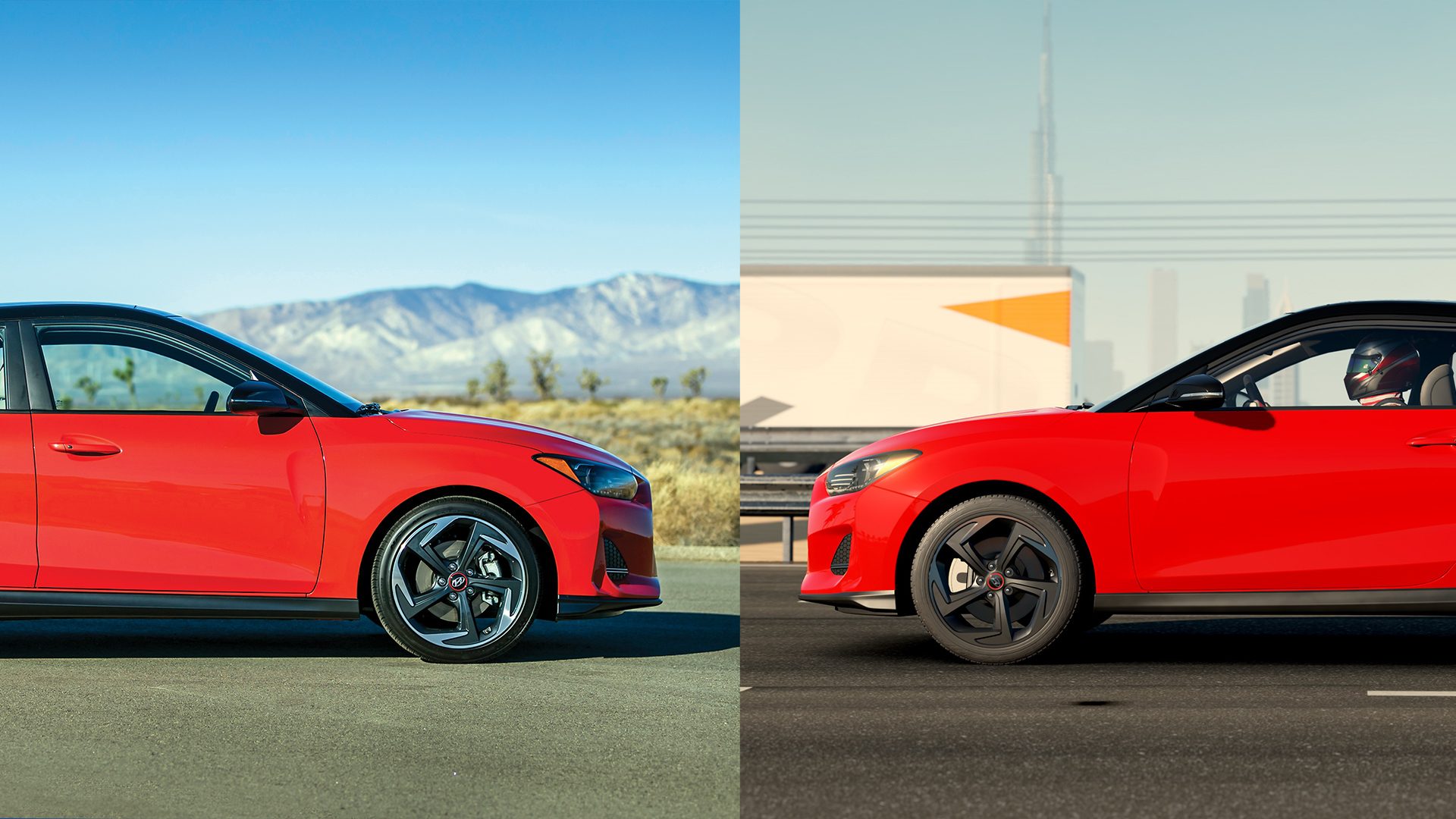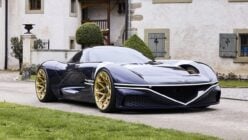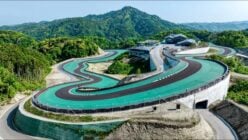Last week, I drove the 2019 Veloster Turbo around the hills outside Austin. It was the first opportunity for the media to drive the real thing — but gamers have had access to it for months now.
You see, the Veloster launched in Forza Motorsport 7 simultaneously with its Detroit Auto Show reveal. It’s not often this happens — though it is increasingly common — but it’s even rarer we get to compare digital and real so early in a car’s life.
So that’s what I’m doing. How close does Forza’s iteration get to the real thing? Let’s find out.
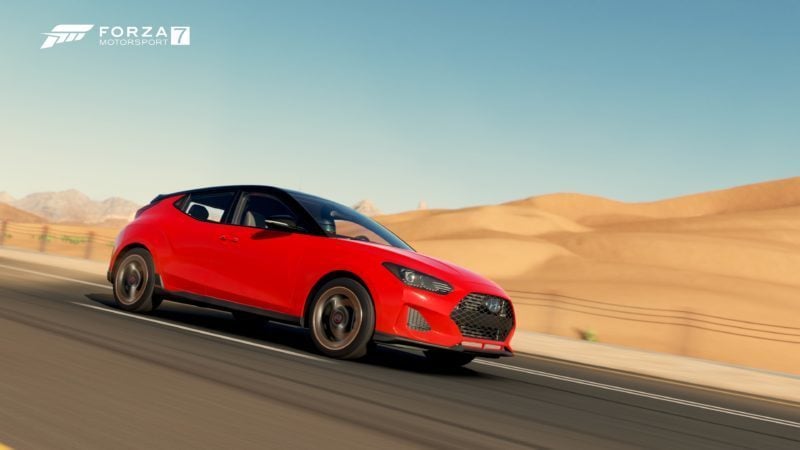
The Specs
I drove both the manual R-Spec and DCT Turbo Ultimate last week. The Veloster Turbo in FM7 is based off the latter; its slightly heavier, and features seven speeds. The 201hp is bang-on, and from memory, the gear ratios seem accurate. First will bump into the limiter right around 30mph.
In-game, the new-age Veloster has a higher PI (Performance Index) rating than the old one. This is likely due to the better-resolved underpinnings and grippier tires (though they’re not those tasty summer-spec Michelins).
The paint options are accurate, but not for Americans. For example, there’s a blue that’s only available North of the border. For the sake of comparison, we’ve stuck with the red/black combo we drove in Austin (affectionately renamed the “Velobster”).
That little turbo engine also sounds accurate. Okay, so a small-capacity turbo engine is hardly the most unique sound on offer in FM7, but nonetheless, the noise when you punch it feels entirely appropriate. It’s louder from the interior view than it should be, but not outrageously so. Let’s just say the sound synthesizer is active.
Convincing? Yes.
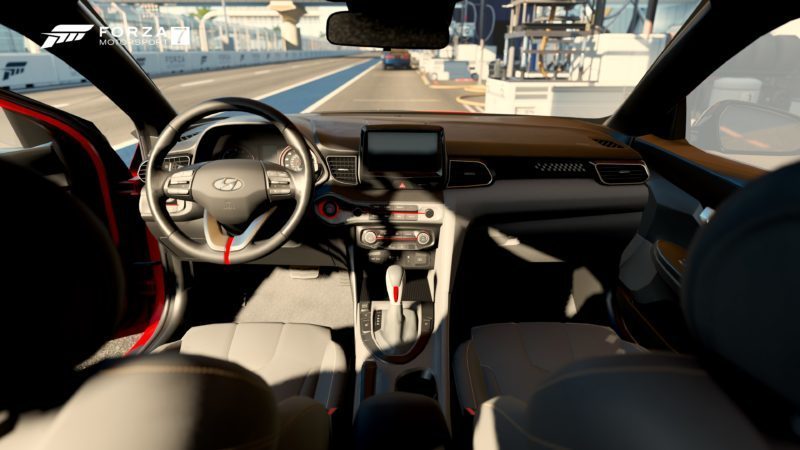
The Interior
It’s bizarre getting into a new car and already feeling familiar with it, at least visually. But that’s just what happened in Austin. Turn 10 has recreated the dash layout accurately in FM7, right down to the little wireless charging section for your phone.
The Ultimate’s red accents perk up the interior, and the view over the wheel feels right. Forza’s field-of-view is narrower than what your own eyes take in, compounded by the fact I sit a little too far away from the screen with my current rig. But move closer, and look around with the stick a bit, and FM7 really does resemble sitting in Hyundai’s newest hatch.
Convincing? Yes.
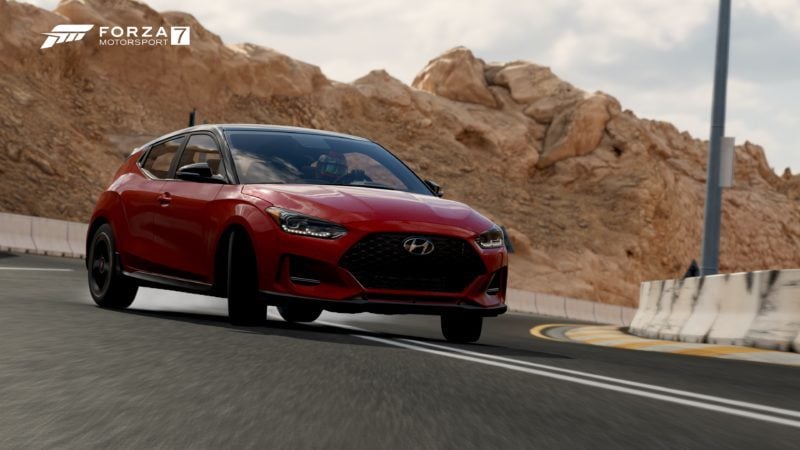
The Driving
Alright, the most important part. Does the Veloster drive as it should?
For the most part, yes. The other two categories are simpler to capture, so this was always going to be the hard sell. To further complicate matters, the real-world experience was out on public roads. I’ve no idea what the Veloster is like at ten tenths, because I’m not a crazy person hell-bent on causing mayhem on the road.
Spirited driving in the twisty bits outside Austin showcased a sure-footed, entertaining little hatch, even at sub-legal speeds. The balance of the chassis is very similar in FM7, exhibiting fine manners and a neutral stance. At least at legal speeds…
That image up top is what happened trail-braking into a corner at Dubai (the closest visual comparison to Austin in-game). The Veloster quickly swung its tail out, and it took more than a dab of oppo from the Fanatec CSL Elite to reel it back in. This was well over 110mph, so there’s no reference for the realism. But had the car pulled this sort of move last week at saner speeds, Hyundai would’ve sent me a bill for redecorating the driver’s seat.
Weirdly enough, it was only that corner, and only with the wheel. Retracing the track with the default Xbox pad, the Veloster acted exactly as I would’ve expected: composed.
The only other fly in the ointment is the low-speed grip, a bugbear in most driving sims. The Veloster is very short-geared, and powering out of corners in-game, it’ll light up the inside front. That on its own isn’t a huge shock — the Turbo lacks the N’s trick diff — but it’s how easily it happens. Even in third, with very little lock applied, the inside front will go orange.
We can look at this from two perspectives. On one hand, no, the real car didn’t do this, and thus, it is unrealistic. On the other, driving the real Veloster provides all sorts of seat-of-the-pants feel that no game can ever convey. It’s a broken record, but it bears repeating: visual and auditory clues are so much more important in game.
This is true of hard acceleration, as well as understeer. When I’d pour the new-age Veloster into a tight set of downhill corners in Austin, and they’d suddenly tighten, the car would communicate the “slow your ass down” message through a combo of inner-ear, hands, and butt. None of this comes through in a racing game, and thus we get tires that are all too quick to speak up — not just in FM7, but in most titles.
Convincing? Yes, so long as the drive stays at typical road-legal speeds. You notice the lack of a diff much more in-game than in real life too, though that can be chalked up to a player aid of sorts.
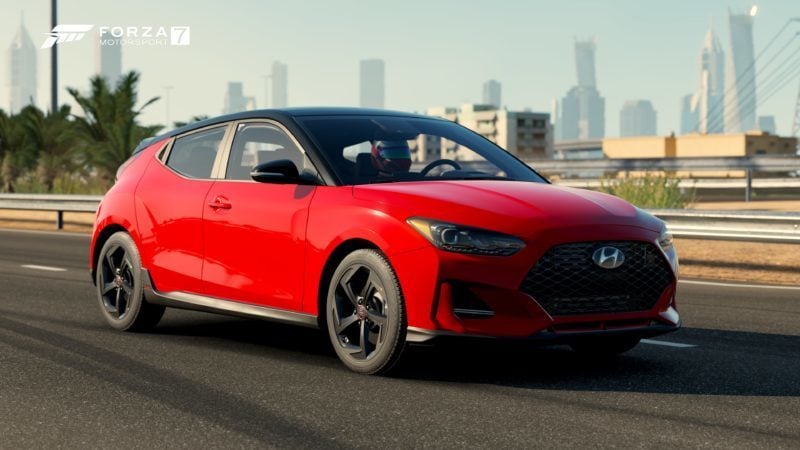
The Verdict
So, does a $60 video game give you an accurate representation of a $29,000 car? Mostly, yes; drive it how you would on the road and the digital Veloster Turbo really does do a solid impression given the limited sensations players can receive. The straight-line performance and general balance of the car is quite convincing — just don’t trail-brake into that Dubai corner at triple digits.
Considering that price of entry gives you access to over 750 other cars, it’s great that sim racers have access to FM7. It’s still not a full substitute for the real thing, but with Velosters starting to show up on dealer lots, a test drive before the test drive wouldn’t hurt.
See more articles on Gaming vs Reality and Hyundai Veloster.
